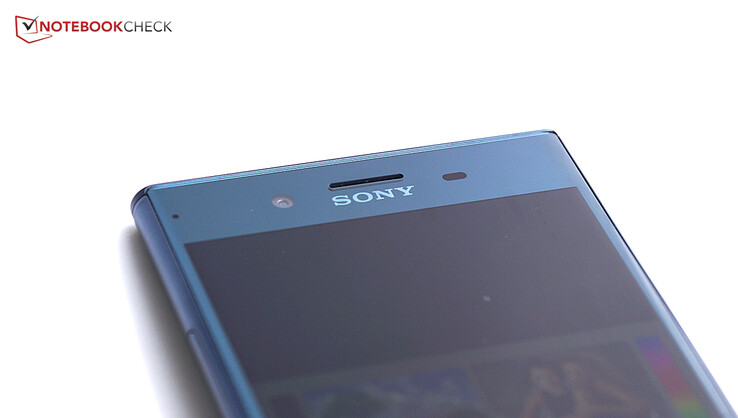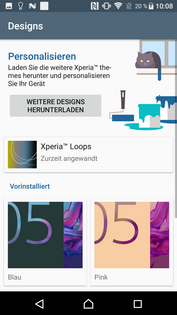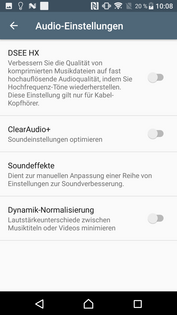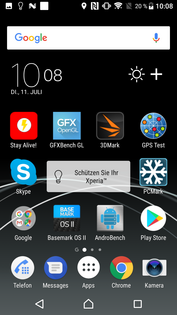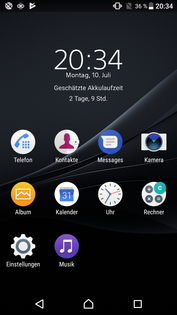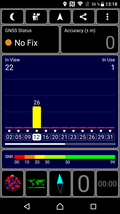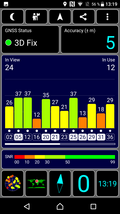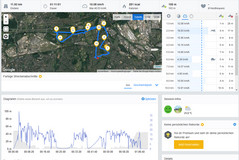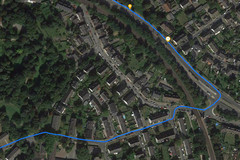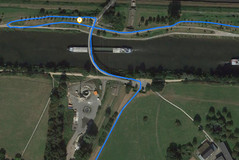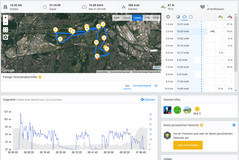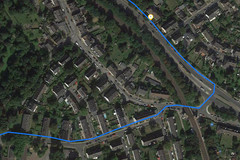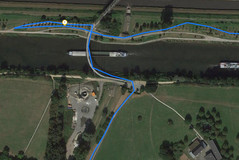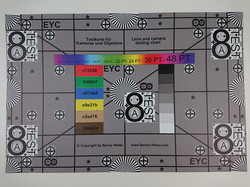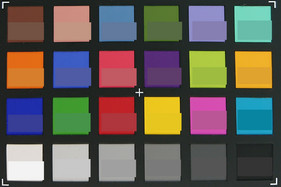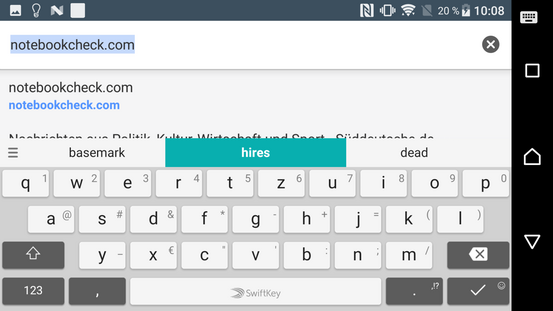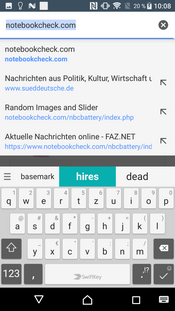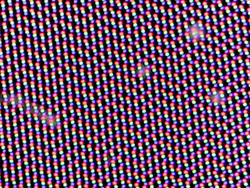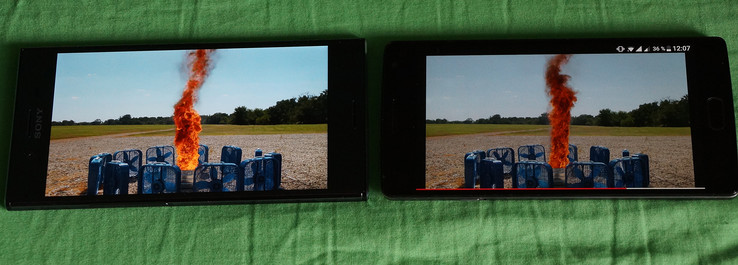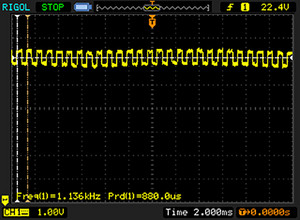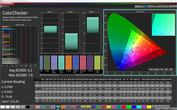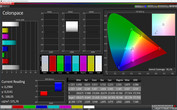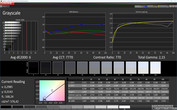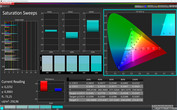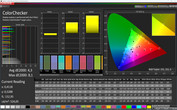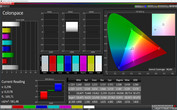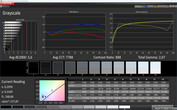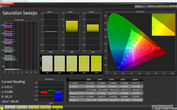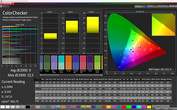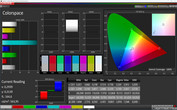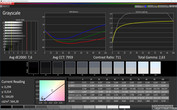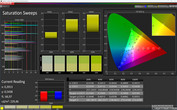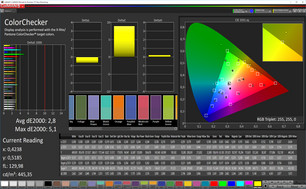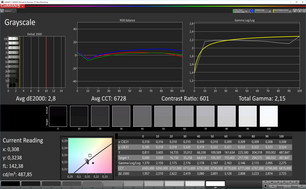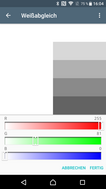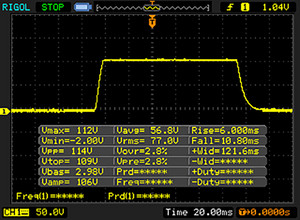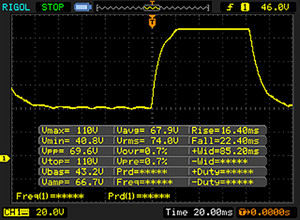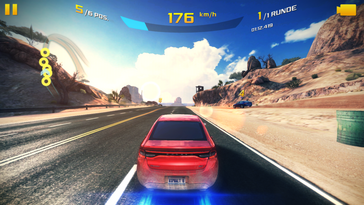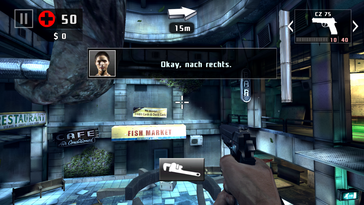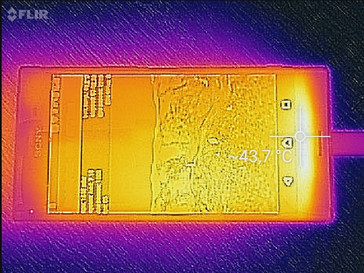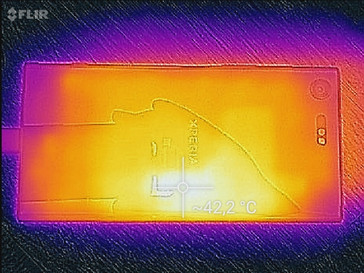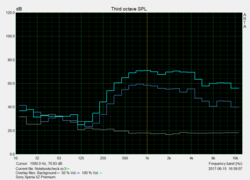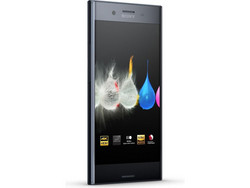Sony Xperia XZ Premium Smartphone Review
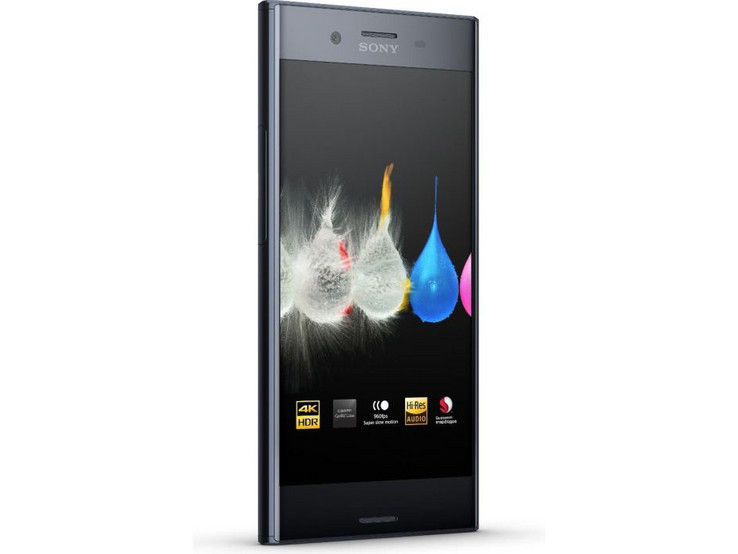
For the original German review, click hereTest Sony Xperia XZ Premium Smartphone.
With Sony smartphones, the best you can get are usually the devices named "Premium". But this tradition is not that old: The Xperia Z5 Premium started the trend at the turn of the year 2015/2016. Then, it was the first smartphone with a 4K display. Since then, many manufacturers have increased the resolution of their smartphone displays, but apart from Sony, nobody has really gone all the way to a full 4K display. Naturally, the Xperia XZ Premium has to outdo this and presents itself with an HDR-ready screen: with suitably optimized content, you will be able to enjoy a wider light spectrum where contrast appears higher and colors brighter. This time, however, Sony's smartphone is not the first to offer HDR. Both Samsung and LG have equipped their flagship phones with HDR-ready displays.
The Xperia XZ Premium also supports high-resolution audio, has improved streaming via Bluetooth and offers noise cancelling with suitable headphones. Compared to the Xperia XZ, our test unit also offers a faster SoC, a wider selection of bandwidths for world-wide use and more storage. All this in exchange for a surcharge of $100 is not a bad deal.
We have compared the Xperia XZ Premium with the current high-end devices from other manufacturers: Apple's iPhone 7 and Samsung's Galaxy S8 Plus are the obvious choices, but the Huawei P10 Plus and Asus ZenFone 3 Deluxe also offer interesting features.
Case
Another tradition among Sony's Premium devices is the reflective case. The Xperia Z5 Premium already had a back cover which you could admire yourself in; the Xperia XZ Premium can also replace your pocket mirror. Maybe Sony wanted to trick us with our vanity and make us mistake our own beauty for the beauty of the case itself. This would not have been necessary, however. Apart from the rather large bezels, which seem a little old-fashioned, we really like the look of the XZ case. The color "Deep-sea Black" is a real looker: it changes between black, blue and green and fits to the device being "Premium". Other color options are silver and pink.
The front and back are covered with Gorilla glass and are quite stable, although medium pressure on the front is visible in the liquid crystals. The phone creaks when warped and the image distorts on the display. We had already noticed this problem in the Xperia Z5 Premium, although this time it is worse. Torsion resistance should be better for an expensive smartphone such as this. The top and bottom of the smartphone have a metallic finish with diamond-cut edges. The transition to the smooth glass surfaces is noticeable, but not unpleasant. Generally, the smartphone has a nice feel and the rounded edges make it very ergonomic. The Xperia XZ Premium slides easily on slanting surfaces due to its smooth exterior. Interestingly enough, the device has almost no problem with fingerprints. They are only visible in very light reflections and can easily be removed. This might be different with the lighter silver design.
Our test unit's dimensions are not too impressive for a 5.5-inch device - Asus had managed to insert a 5.7-inch display into the ZenFone 3 Deluxe with very similar dimensions. In terms of weight the Xperia XZ Premium is the heaviest of all comparison devices with 191 grams (~6.7 oz). Nevertheless, as mentioned above, it is still nice to handle.
Like its predecessor, the Xperia XZ Premium is resistant to water and dust. IP 68 is the highest level of protection against dust and the second highest for water, which means that fresh water and rain are no problem. This has become a standard among high-end devices.
Connectivity
The Sony Xperia XZ Premium is well-equipped with 64 GB of storage and 4 GB of RAM, although this configuration does not make it stand out of the crowd of high-end smartphones. The winners here are the Huawei P10 Plus and the Asus ZenFone 3 Deluxe, which each have 128 GB of storage and 6 GB of RAM.
The device is equipped with NFC and a USB-C port with USB OTG and USB 3.0; it can read microSD cards up to 256 GB, which can only be formatted as external storage. Therefore, you cannot save apps onto the microSD card.
Software
Sony has given Android 7.1.1 a proper makeover with new functions and more Material Design options. At the time of testing, the security patches were more or less up to date (June 1st 2017). When we first started the phone, the interface seemed a little overloaded. Apps are grouped into folders even in the app overview, which can make it difficult to find the right app sometimes. The full-text search makes this a lot easier. The welcoming app introduces us to new functions and, depending on which phone you had previously, explains how to operate the new phone. Naturally, a Sony smartphone cannot come without a PlayStation app, with which you can stream games from the PS4 onto the smartphone. With a PS4 Pro, games can even be streamed in 1080p, but 4K resolution is not possible.
Sony has installed its own apps for music, photos and videos, which unfortunately do not replace the Google apps. We would suggest choosing a preferred app and deactivating or deleting the other. The device also comes with some advertising apps - if you prefer a clean system, you will have to delete some apps at the beginning. Sony's own app store "What's New", a messaging app, Movie Creator, a drawing app and the Xperia Lounge, where you can find competitions and news connected to Xperia smartphones and other content from Sony, are also installed. Xperia Actions learns from your actions on the smartphone and gives you tips on how to make better use of the device. You can customize the software's appearance with Designs. Sony's software is lavish and the manufacturer's love for detail is admirable. Some users, however, will never use many of the functions and bloatware are, of course, annoying. So you will have to decide: The Xperia smartphones are probably not suitable for fans of simple, pure Android software. But if you like having a lot of functions prepared for you and think it is nice that Sony has added graphic elements in many places, you will be very happy with the of the Xperia XZ Premium's software.
Communication & GPS
Sony has equipped our test unit with a Qualcomm Snapdragon 835, which is one of the most modern modems currently available for smartphones. It supports LTE cat. 16 and can - as with the Samsung Galaxy S8 - receive data in Gigabit speed via the mobile phone network. The Sony Xperia XZ Premium supports so many LTE frequencies that you can easily call it a "Global Phone" - a smartphone that can be used all over the world. In the UK, the device is available as Dual SIM. In the well-developed German E-network, we had good reception even inside a city apartment.
The WLAN module supports all current standards: 802.11 a/b/g/n/ac. The outdated "a" standard means that it is also possible to connect to 5.0 GHz networks. The Xperia XZ Premium proves to be a very fast smartphone - it is even the fastest at receiving data. When you are near the router, there are no problems in terms of speed: pages are fully loaded in an instant and the device has full reception. At a distance of 10 meters (~32.8 ft) and through three walls, reception varies between 3/4 and 1/4 and some websites do not load at all. The Xperia XZ Premium seems to have difficulties with Wi-Fi reception if you are at a certain distance from the router. As soon as you move closer, pages start loading faster again.
| Networking | |
| iperf3 transmit AX12 | |
| Samsung Galaxy S8 Plus (Linksys EA8500, 5.0 GHz) | |
| Sony Xperia XZ Premium (Linksys EA8500, 5.0 GHz) | |
| Huawei P10 Plus (Linksys EA8500, 5.0 GHz) | |
| Asus ZenFone 3 Deluxe ZS570KL (Linksys EA8500, 2.4 GHz) | |
| iperf3 receive AX12 | |
| Sony Xperia XZ Premium (Linksys EA8500, 5.0 GHz) | |
| Samsung Galaxy S8 Plus (Linksys EA8500, 5.0 GHz) | |
| Asus ZenFone 3 Deluxe ZS570KL (Linksys EA8500, 2.4 GHz) | |
| Huawei P10 Plus (Linksys EA8500, 5.0 GHz) | |
The Sony Xperia XZ Premium cannot locate us indoors. GPS reception improves a lot outdoors and can locate our position within 5 meters (~16.4 ft). This is a mediocre result.
In order to make a proper evaluation of the GPS module, we took it on a bicycle ride. The Garmin Edge 500 also joined us as a comparison device. The Xperia XZ Premium measured a longer route than the professional navigation system - something that has never happened before. Perhaps this is because the module seems rather distracted even on straight roads, and invented an additional trip into a field after crossing the bridge. The Garmin Edge 500, on the other hand, correctly located us on the path. You can tell from the more angular route that the Sony Xperia XZ Premium uses way fewer location points than the comparison device, as it has to draw straight lines between two points that are quite far apart. The Xperia XZ Premium can definitely be used as a navigation system for leisure time activities, but there are a lot of smartphones that offer more exact results.
Telephone & Voice Quality
The telephone app comes from Google and is the same as in many other Android smartphones. It is very easy to use.
We have often praised Sony for its voice quality, for example, in the Sony Xperia Z3. But for some time past now, the manufacturer seems to have lost interest in this respect and the voice quality is often mediocre. The Xperia XZ Premium is no exception: Our contact sounds strangely muffled and even a little distorted via the earpiece; our own voice does not sound good to our call partner either. At maximum volume you can clearly hear background noise. The same goes for the speakers: the sound is weak, our contact still sounds muffled and there is noise at maximum volume. Our voice is loud enough, but does not sound particularly clear either. The audio enhancement tool ClearAudio+ does show slight improvements, but our caller still does not sound really good.
Cameras
Sony has lowered the MP of the main camera compared to the Xperia XZ, but 19 MP is still a lot of pixels. Apart from that, the technical specifications of the sensors are the same: wide-angle lens, high ISO sensitivity for good pictures in low lighting and 4K video recording. Sony has added an important function for the Xperia XZ Premium: a super-slow-motion function with up to 960 images per second.
But first let us take a look at the pictures from the main camera: With the Xperia XZ we had noticed a slight red tinge; the images from the Xperia XZ Premium seem quite a bit cooler. The Xperia XZ's camera also had higher sharpness of detail. With the XZ Premium small parts of the image often seem washed out and the grass in the first picture simply looks like a mush of pixels. The cameras of the comparison devices HTC U11 and Galaxy S8 Plus clearly show more details. Images taken in low lighting seem good at first glance, but a closer look shows that they are very blurry. The HTC U11's camera takes much sharper shots. An advantage of the Sony Xperia XZ Premium: We noticed hardly any color noise.
The front camera gets the same verdict as that of the Xperia XZ: the very high resolution, great sharpness and good color accuracy make it a perfect selfie camera. It clearly offers better quality than the main camera.
In terms of video, the device offers the possibility to record 4K videos, but only via a special Sony app or third-party apps. Opening the app is rather awkward - why does Sony's camera app still not offer native 4K video recording, after all these years? Sony warns that the device could heat up a lot while filming in 4K. We had already noticed this with the Xperia Z2. But even after filming in 4K for several minutes, we noticed no such rise in temperature, so the warning for the Xperia XZ Premium seems to be merely a formality. The image quality of the recorded videos is good, as is exposure adjustment. It is annoying however that you cannot focus manually in the app, but you have to rely on auto focus instead.
Sony has made a big thing about its super-slow-motion function: The device can record up to 960 images per second (instead of 30). This enables great shots of fast-moving objects. At least this feature is directly accessible through the camera app, but there are some restrictions. Videos can only be taken in 720p and not in every position. Recording starts as a normal video and you have to then press the slow-motion button at the right moment, in order to record in super-slow-motion for one second. This creates a kind of Bullet Time effect, the way they are familiar from movies and music videos, but does limit possibilities. Alternatively, you can also record in slow-motion for five seconds without starting with a normal video. You can record slow-motion videos with 120 images per second for any amount of time, and then decide when slow-motion should start and end later on. Overall, super-slow-motion recording does make impressive shots. Even if this feature is limited to short spells and low resolution, it is impressive to watch a bird flying or water in a glass - like in our example video which we will link below. We hope that Sony will continue to develop this technology.
If you toggle the test chart, which we photographed under controlled lighting in our laboratory, it is easy to see that large surfaces are often patchy. Black writing on yellow background seems a little blurred and the bottom left corner is clearly fuzzy. Overall, the image is reproduced quite well, but reflects the problems that we found in the two test shots: colors are sometimes too dark, sometimes too light, and dark tones are closest to the reference colors.
Accessories & Warranty
The Xperia XZ Premium comes with a standard power supply and a USB-C cable. We are surprised that a QuickCharge 3.0 power supply is not included. The device does have a headset, but this is a very basic model that does not support noise cancelling, although the smartphone would. You can expect to pay about $60 for such a headset that also supports high-resolution audio. Sony also offers a Bluetooth hands-free system that has a shutter release for selfies, which is available for about $70. A cover for the XX Premium costs about $10.
Warranty for the Xperia XZ Premium lasts 24 months. Please see our Guarantees, Return policies and Warranties FAQ for country-specific information.
Input Devices & Handling
Sony has installed SwiftKey, but of course you can download and install Google's GBoard or any other keyboard from the PlayStore if you wish. SwiftKey can be easily customized and is easy to use, although keys are mapped with two functions, which negatively impacts clarity.
All physical buttons are on the right side of the Xperia XZ Premium: The volume rocker, the lowered standby button and a shutter release button for the camera. All of these buttons are recognizable by touch, but the volume rocker has an unclear pressure point. The fingerprint sensor is integrated in the standby button, but only reacts after the button has been pressed once. To wake up the phone from standby, you have to press the button and your fingerprint will be read automatically.
The Android keys are on the screen and the touchscreen feels nice; it is smooth and gliding is easy with precise gesture recognition even in the corners. There also is a glove mode, which enables you to use the phone with thin gloves in winter.
Display
The display is definitely one of the highlights of the Xperia XZ Premium: It has a great resolution of 3840x2160 pixels, but the best part is that the display supports HDR content with very high contrast and vivid colors. You can see how great that looks in our comparison photo of the Xperia XZ Premium and the OnePlus 2 with a usual 1080p display without HDR. We used an HDR video on YouTube for our comparison: The colors are a lot more vivid and stronger, while dark surfaces remain dark without losing any details. It basically feels as if you could touch every detail. The image on the OnePlus 2 is also sharp, but a lot weaker and less vivid. And the Xperia XZ Premium does not even have an AMOLED display, but a simple IPS screen. The high brightness with an average of 568 cd/m² is necessary to display the high contrasts. It has 92% brightness distribution, which means that you cannot notice any inconsistencies even on large areas.
| |||||||||||||||||||||||||
Brightness Distribution: 92 %
Center on Battery: 578 cd/m²
Contrast: 932:1 (Black: 0.62 cd/m²)
ΔE ColorChecker Calman: 2.8 | ∀{0.5-29.43 Ø4.78}
ΔE Greyscale Calman: 2.8 | ∀{0.09-98 Ø5}
Gamma: 2.15
CCT: 6728 K
| Sony Xperia XZ Premium IPS, 3840x2160, 5.5" | Apple iPhone 7 Plus IPS, 1920x1080, 5.5" | Asus ZenFone 3 Deluxe ZS570KL AMOLED, 1920x1080, 5.7" | Huawei P10 Plus LTPS, 2560x1440, 5.5" | Samsung Galaxy S8 Plus Super AMOLED, 2960x1440, 6.2" | |
|---|---|---|---|---|---|
| Screen | 32% | -19% | 15% | 19% | |
| Brightness middle (cd/m²) | 578 | 557 -4% | 464 -20% | 568 -2% | 560 -3% |
| Brightness (cd/m²) | 568 | 553 -3% | 468 -18% | 562 -1% | 562 -1% |
| Brightness Distribution (%) | 92 | 97 5% | 85 -8% | 92 0% | 93 1% |
| Black Level * (cd/m²) | 0.62 | 0.35 44% | 0.43 31% | ||
| Contrast (:1) | 932 | 1591 71% | 1321 42% | ||
| Colorchecker dE 2000 * | 2.8 | 1.4 50% | 3.2 -14% | 2.4 14% | 1.7 39% |
| Colorchecker dE 2000 max. * | 5.1 | 3.1 39% | 10.5 -106% | 3.8 25% | 3.4 33% |
| Greyscale dE 2000 * | 2.8 | 1.3 54% | 1.4 50% | 2.5 11% | 1.6 43% |
| Gamma | 2.15 102% | 2.21 100% | 2.27 97% | 2.37 93% | 2.13 103% |
| CCT | 6728 97% | 6667 97% | 6590 99% | 6779 96% | 6435 101% |
| Color Space (Percent of AdobeRGB 1998) (%) | 63.1 | 81.57 | |||
| Color Space (Percent of sRGB) (%) | 99.83 | 99.87 |
* ... smaller is better
Screen Flickering / PWM (Pulse-Width Modulation)
| Screen flickering / PWM detected | 1136 Hz | ≤ 33 % brightness setting | |
The display backlight flickers at 1136 Hz (worst case, e.g., utilizing PWM) Flickering detected at a brightness setting of 33 % and below. There should be no flickering or PWM above this brightness setting. The frequency of 1136 Hz is quite high, so most users sensitive to PWM should not notice any flickering. In comparison: 53 % of all tested devices do not use PWM to dim the display. If PWM was detected, an average of 8101 (minimum: 5 - maximum: 343500) Hz was measured. | |||
The high black value of 0.62 cd/m2 is a disadvantage and Sony would have had a better result with an AMOLED display. The same goes for the maximum contrast of 932:1. Sony uses pulse-width modulation from 33% brightness. The idea is simple: the screen is turned off for a fraction of a second and appears darker to the slow human eye. This happens 1136 times per second in the Xperia XZ Premium, which should not even affect sensitive users.
Sony promises higher color space coverage than normal smartphone screens have, and offers a special mode which is supposed to display colors particularly accurately for professional use. But even in this mode, we detected a clear blue cast and too much color deviation for professionals. Luckily we could manually optimize the white balance, which also dealt with the blue cast and lowered color deviation to a minimum. Subjectively, the mode "Super Vivid" is the most pleasant: the colors are bright and the high quality of the screen is even noticeable in the menu where it makes everything appear more tangible. Color space coverage is highest in this mode, but so is color deviation, especially with blue tones.
Display Response Times
| ↔ Response Time Black to White | ||
|---|---|---|
| 16.8 ms ... rise ↗ and fall ↘ combined | ↗ 6 ms rise | |
| ↘ 10.8 ms fall | ||
| The screen shows good response rates in our tests, but may be too slow for competitive gamers. In comparison, all tested devices range from 0.1 (minimum) to 240 (maximum) ms. » 37 % of all devices are better. This means that the measured response time is better than the average of all tested devices (20.2 ms). | ||
| ↔ Response Time 50% Grey to 80% Grey | ||
| 38.8 ms ... rise ↗ and fall ↘ combined | ↗ 16.4 ms rise | |
| ↘ 22.4 ms fall | ||
| The screen shows slow response rates in our tests and will be unsatisfactory for gamers. In comparison, all tested devices range from 0.165 (minimum) to 636 (maximum) ms. » 57 % of all devices are better. This means that the measured response time is worse than the average of all tested devices (31.6 ms). | ||
The Xperia XZ Premium can be used well outdoors, which is mainly due to its very high brightness. The display is quite reflective; however, so you will have to move into the shade in lighter surroundings.
The viewing angles are very good; only from the sides do you notice a little dimming.
Performance
Sony has equipped the Xperia XZ Premium with a very fast SoC: the Snapdragon 835 from Qualcomm. It has a total of eight cores, of which four work at full clock rate (2.46 GHz) and four at a reduced clock rate (1.9 GHz). The Sony Xperia XZ Premium is a fast smartphone that can even beat the Samsung Galaxy S8 Plus in many of the benchmarks. We noticed no lagging in everyday use; programs start quickly and the Xperia XZ Premium has no problems with many apps being open in the background.
The device's graphics are taken care of by the Qualcomm Adreno 540, which is also very fast at 710 MHz and is at the front of the race, even if it cannot quite keep up with the framerates of the iPhone 7 or the Galaxy S8 Plus in all benchmarks.
| AnTuTu v6 - Total Score (sort by value) | |
| Sony Xperia XZ Premium | |
| Apple iPhone 7 Plus | |
| Asus ZenFone 3 Deluxe ZS570KL | |
| Huawei P10 Plus | |
| Samsung Galaxy S8 Plus | |
| PCMark for Android | |
| Work performance score (sort by value) | |
| Sony Xperia XZ Premium | |
| Asus ZenFone 3 Deluxe ZS570KL | |
| Huawei P10 Plus | |
| Samsung Galaxy S8 Plus | |
| Work 2.0 performance score (sort by value) | |
| Sony Xperia XZ Premium | |
| Huawei P10 Plus | |
| Samsung Galaxy S8 Plus | |
| Geekbench 4.4 | |
| 64 Bit Single-Core Score (sort by value) | |
| Sony Xperia XZ Premium | |
| Huawei P10 Plus | |
| Samsung Galaxy S8 Plus | |
| 64 Bit Multi-Core Score (sort by value) | |
| Sony Xperia XZ Premium | |
| Huawei P10 Plus | |
| Samsung Galaxy S8 Plus | |
| Compute RenderScript Score (sort by value) | |
| Sony Xperia XZ Premium | |
| Samsung Galaxy S8 Plus | |
| GFXBench (DX / GLBenchmark) 2.7 | |
| T-Rex Onscreen (sort by value) | |
| Sony Xperia XZ Premium | |
| Apple iPhone 7 Plus | |
| Asus ZenFone 3 Deluxe ZS570KL | |
| Huawei P10 Plus | |
| Samsung Galaxy S8 Plus | |
| 1920x1080 T-Rex Offscreen (sort by value) | |
| Sony Xperia XZ Premium | |
| Apple iPhone 7 Plus | |
| Asus ZenFone 3 Deluxe ZS570KL | |
| Huawei P10 Plus | |
| Samsung Galaxy S8 Plus | |
| GFXBench 3.0 | |
| on screen Manhattan Onscreen OGL (sort by value) | |
| Sony Xperia XZ Premium | |
| Apple iPhone 7 Plus | |
| Asus ZenFone 3 Deluxe ZS570KL | |
| Huawei P10 Plus | |
| Samsung Galaxy S8 Plus | |
| 1920x1080 1080p Manhattan Offscreen (sort by value) | |
| Sony Xperia XZ Premium | |
| Apple iPhone 7 Plus | |
| Asus ZenFone 3 Deluxe ZS570KL | |
| Huawei P10 Plus | |
| Samsung Galaxy S8 Plus | |
| GFXBench 3.1 | |
| on screen Manhattan ES 3.1 Onscreen (sort by value) | |
| Sony Xperia XZ Premium | |
| Apple iPhone 7 Plus | |
| Asus ZenFone 3 Deluxe ZS570KL | |
| Huawei P10 Plus | |
| Samsung Galaxy S8 Plus | |
| 1920x1080 Manhattan ES 3.1 Offscreen (sort by value) | |
| Sony Xperia XZ Premium | |
| Apple iPhone 7 Plus | |
| Asus ZenFone 3 Deluxe ZS570KL | |
| Huawei P10 Plus | |
| Samsung Galaxy S8 Plus | |
| GFXBench | |
| on screen Car Chase Onscreen (sort by value) | |
| Sony Xperia XZ Premium | |
| Asus ZenFone 3 Deluxe ZS570KL | |
| Huawei P10 Plus | |
| Samsung Galaxy S8 Plus | |
| 1920x1080 Car Chase Offscreen (sort by value) | |
| Sony Xperia XZ Premium | |
| Asus ZenFone 3 Deluxe ZS570KL | |
| Huawei P10 Plus | |
| Samsung Galaxy S8 Plus | |
The Xperia XZ Premium is not the fastest possible high-end smartphone, but that is just being fussy: The Sony Xperia XZ Premium loads web pages very quickly and has no problem with demanding HTML5 games, as we found out on letsplay.ouigo.com.
| JetStream 1.1 - Total Score | |
| Apple iPhone 7 Plus | |
| Samsung Galaxy S8 Plus | |
| Sony Xperia XZ Premium | |
| Asus ZenFone 3 Deluxe ZS570KL | |
| Huawei P10 Plus | |
| Octane V2 - Total Score | |
| Apple iPhone 7 Plus | |
| Samsung Galaxy S8 Plus | |
| Sony Xperia XZ Premium | |
| Huawei P10 Plus | |
| Asus ZenFone 3 Deluxe ZS570KL | |
| Mozilla Kraken 1.1 - Total | |
| Sony Xperia XZ Premium | |
| Huawei P10 Plus | |
| Asus ZenFone 3 Deluxe ZS570KL | |
| Samsung Galaxy S8 Plus | |
| Apple iPhone 7 Plus | |
| WebXPRT 2015 - Overall | |
| Apple iPhone 7 Plus | |
| Samsung Galaxy S8 Plus | |
| Sony Xperia XZ Premium | |
| Huawei P10 Plus | |
| Asus ZenFone 3 Deluxe ZS570KL | |
* ... smaller is better
The Sony smartphone did not do so well when we tested reading and writing speeds on our reference card, the Toshiba Exceria Pro M401. It has the lowest transfer rates among all comparison devices and is not even half as fast as it theoretically could be. The Xperia XZ Premium is not particularly fast at accessing internal storage, either, but here at least it manages an average speed.
| AndroBench 3-5 | |
| Sequential Read 256KB | |
| Samsung Galaxy S8 Plus | |
| Huawei P10 Plus | |
| Sony Xperia XZ Premium | |
| Asus ZenFone 3 Deluxe ZS570KL | |
| Sequential Write 256KB | |
| Samsung Galaxy S8 Plus | |
| Sony Xperia XZ Premium | |
| Huawei P10 Plus | |
| Asus ZenFone 3 Deluxe ZS570KL | |
| Random Read 4KB | |
| Huawei P10 Plus | |
| Samsung Galaxy S8 Plus | |
| Asus ZenFone 3 Deluxe ZS570KL | |
| Sony Xperia XZ Premium | |
| Random Write 4KB | |
| Huawei P10 Plus | |
| Sony Xperia XZ Premium | |
| Samsung Galaxy S8 Plus | |
| Asus ZenFone 3 Deluxe ZS570KL | |
| Sequential Read 256KB SDCard | |
| Asus ZenFone 3 Deluxe ZS570KL (Toshiba Exceria Pro M401) | |
| Samsung Galaxy S8 Plus (Toshiba Exceria Pro M401) | |
| Huawei P10 Plus (Toshiba Exceria Pro M401) | |
| Sony Xperia XZ Premium (Toshiba Exceria Pro M401) | |
| Sequential Write 256KB SDCard | |
| Asus ZenFone 3 Deluxe ZS570KL (Toshiba Exceria Pro M401) | |
| Samsung Galaxy S8 Plus (Toshiba Exceria Pro M401) | |
| Huawei P10 Plus (Toshiba Exceria Pro M401) | |
| Sony Xperia XZ Premium (Toshiba Exceria Pro M401) | |
Games
We downloaded a few games and tested them on the Sony Xperia XZ Premium. The fast racing game “Asphalt 8: Airborne can be played with 30 frames per second with very high settings. Dead Trigger 2” runs very smoothly at 60 fps. It is not surprising that less demanding games such as “Angry Birds” are no problem for the phone. It is important that the graphics unit supports all current APIs when thinking about future use, as this will be necessary in order to continue playing games in the coming years. This is the case with the Sony Xperia XZ Premium.
The position sensor and touchscreen work well and are reliable.
| Asphalt 8: Airborne | |||
| Settings | Value | ||
| high | 30 fps | ||
| very low | 30 fps | ||
| Dead Trigger 2 | |||
| Settings | Value | ||
| high | 60 fps | ||
Emissions
Temperature
Case temperatures have not always been Sony's strong point in the past. But it seems to have got them under control in the Xperia XZ Premium. A maximum of 42.1 °C (~107.8 °F) around the earpiece shows that while temperatures do increase when under load for prolonged period of time (and this in a suboptimal area - who wants to hold a warm telephone to their ear, after all), they are still acceptable, especially as heat development in other areas of the case is lower. The case is also noticeably warm (max. 39.4 °C/~102.9 °F) while idling.
We were happy to find, however, that the SoC has no problems with temperatures and can keep up its performance even after a prolonged period under load. This was proven by the T-Rex battery test from GFXBench.
(±) The maximum temperature on the upper side is 42.1 °C / 108 F, compared to the average of 35.2 °C / 95 F, ranging from 21.9 to 247 °C for the class Smartphone.
(+) The bottom heats up to a maximum of 39.5 °C / 103 F, compared to the average of 34 °C / 93 F
(±) In idle usage, the average temperature for the upper side is 36.1 °C / 97 F, compared to the device average of 32.9 °C / 91 F.
Speakers
The sound of the two front speakers is acceptable, but highs are too audible, especially at high volume. Although "high" is relative: with 79.7 dB(A), the speakers are quieter than those of many of the comparison devices. Considering that good sound quality, high-resolution compatibility of the smartphone and its technical sound improvements are so important to Sony, the speakers are really only average. We managed to improve the sound a little with Equalizer and you can even turn on virtual Surround Sound.
Sony has added a headset to the box that can be connected via the 3.5 mm audio jack, which audio enthusiasts will be happy to hear. But the fact that the headset does not support noise cancelling and generally seems to be rather basic is incomprehensible for this price range. The sound is decent and the output via the 3.5-mm port is noise-free and of good quality. Sony wants to enhance the sound of the headphones with the help of various improvements: DSEE HX restores highs that were lost during compression, and the difference is really audible. Apart from the fact that high-resolution audio files can be played without any losses, the smartphone monitors the use of the headphones and adapts settings in order to offer users the best sound quality.
Bluetooth 5.0 and Sony's own LDAC are supposed to support streaming to external speakers in high-resolution quality. Unfortunately, our test speakers only support Bluetooth 4.2 and Android does not yet support Bluetooth 5.0. The sound was still transmitted well and without any interference.
Sony Xperia XZ Premium audio analysis
(±) | speaker loudness is average but good (79.7 dB)
Bass 100 - 315 Hz
(-) | nearly no bass - on average 24% lower than median
(-) | bass is not linear (15.3% delta to prev. frequency)
Mids 400 - 2000 Hz
(±) | higher mids - on average 7.3% higher than median
(+) | mids are linear (6.5% delta to prev. frequency)
Highs 2 - 16 kHz
(+) | balanced highs - only 4.9% away from median
(+) | highs are linear (5.5% delta to prev. frequency)
Overall 100 - 16.000 Hz
(±) | linearity of overall sound is average (26% difference to median)
Compared to same class
» 65% of all tested devices in this class were better, 6% similar, 28% worse
» The best had a delta of 11%, average was 35%, worst was 134%
Compared to all devices tested
» 79% of all tested devices were better, 4% similar, 16% worse
» The best had a delta of 4%, average was 24%, worst was 134%
Samsung Galaxy S8 Plus audio analysis
(+) | speakers can play relatively loud (82.9 dB)
Bass 100 - 315 Hz
(-) | nearly no bass - on average 21.5% lower than median
(±) | linearity of bass is average (12% delta to prev. frequency)
Mids 400 - 2000 Hz
(±) | higher mids - on average 5.2% higher than median
(+) | mids are linear (3.8% delta to prev. frequency)
Highs 2 - 16 kHz
(±) | higher highs - on average 5.2% higher than median
(±) | linearity of highs is average (7.7% delta to prev. frequency)
Overall 100 - 16.000 Hz
(±) | linearity of overall sound is average (22.2% difference to median)
Compared to same class
» 46% of all tested devices in this class were better, 7% similar, 47% worse
» The best had a delta of 11%, average was 35%, worst was 134%
Compared to all devices tested
» 64% of all tested devices were better, 6% similar, 30% worse
» The best had a delta of 4%, average was 24%, worst was 134%
Frequency diagram in comparison (checkboxes above can be turned on/off)
Battery Runtime
Power Consumption
The Xperia XZ Premium's power consumption is quite modest: it has the lowest minimum consumption of all comparison devices. Unfortunately, after that it increases drastically and consumes a maximum of 2.59 watts while idling, which is rather high. The average consumption under load is good, as is the maximum value: 7.91 watts.
The device recharges in about 1 and 1/2 hours with QuickCharge 3.0. It takes about half an hour longer with the supplied power supply.
| Off / Standby | |
| Idle | |
| Load |
|
Key:
min: | |
| Sony Xperia XZ Premium 3230 mAh | Apple iPhone 7 Plus 2915 mAh | Asus ZenFone 3 Deluxe ZS570KL 3000 mAh | Huawei P10 Plus 3750 mAh | Samsung Galaxy S8 Plus 3500 mAh | |
|---|---|---|---|---|---|
| Power Consumption | 0% | 0% | -30% | 28% | |
| Idle Minimum * (Watt) | 0.62 | 0.77 -24% | 0.85 -37% | 1.03 -66% | 0.68 -10% |
| Idle Average * (Watt) | 2.44 | 2.04 16% | 1.2 51% | 2.61 -7% | 1.13 54% |
| Idle Maximum * (Watt) | 2.59 | 2.24 14% | 1.25 52% | 2.83 -9% | 1.16 55% |
| Load Average * (Watt) | 4.94 | 4.69 5% | 6.97 -41% | 7.03 -42% | 4.69 5% |
| Load Maximum * (Watt) | 7.91 | 8.66 -9% | 9.74 -23% | 10.08 -27% | 5.24 34% |
* ... smaller is better
Battery Runtime
The battery has 3230 mAh or 11.3 watt hours and gives the Sony Xperia XZ Premium a good 11:35 hours runtime in our Wi-Fi test. Even if you should continue surfing for the entire work day, you would still have enough juice for the evening. It is not surprising therefore, that the battery lasts two days with normal use and even three days if you are careful. The device has two energy-saving modes "Stamina" and "Ultra Stamina"; it is annoying that you have to restart the device after using Ultra Stamina.
| Sony Xperia XZ Premium 3230 mAh | Apple iPhone 7 Plus 2915 mAh | Asus ZenFone 3 Deluxe ZS570KL 3000 mAh | Huawei P10 Plus 3750 mAh | Samsung Galaxy S8 Plus 3500 mAh | |
|---|---|---|---|---|---|
| Battery runtime | -3% | -23% | -7% | 2% | |
| Reader / Idle (h) | 29.2 | 30.6 5% | 23.2 -21% | 27.6 -5% | 26.1 -11% |
| H.264 (h) | 13.4 | 13.6 1% | 13.3 -1% | 12.6 -6% | 12.4 -7% |
| WiFi v1.3 (h) | 11.6 | 9.8 -16% | 7.7 -34% | 12.7 9% | 12.3 6% |
| Load (h) | 3.9 | 3.8 -3% | 2.5 -36% | 2.9 -26% | 4.6 18% |
Pros
Cons
Verdict
Oh Sony, how great it is that for the second time you have made a high-end smartphone with innovative technological features available. The Xperia XZ Premium impresses with high-resolution sound, noise cancelling with the appropriate headphones and a slow-motion function that works really well. And all of that just for a few dollars more compared to the Xperia XZ. Then come good battery runtimes and of course the phenomenal HDR screen of which we hope that will become a standard for high-end devices. If only Sony had used an AMOLED screen here....
But it is a shame, on the other hand, that compared to these technical highlights, its outside seems rather out-of-date: the case is heavy and although elegant, is easy to distort. The wide bezels do not help to make the display appear modern. On top of that, the device has only standard storage capacity, a slow GPS module, mediocre Wi-Fi reception further away from the router and not particularly good call quality. The accessories lack Quick Charge and the cheap headset is not worthy of a flagship device.
The Xperia XZ Premium is a device with many new technologies that has proven that 4K videos and HDR can look impressive even on a smartphone display. It has a convincing battery runtime and slow-motion function, but Sony could have put more effort into basic capabilities such as call quality and Wi-Fi reception.
Had Sony been a little braver, they could have made the Xperia XZ Premium into an outstanding smartphone, eclipsing its competition. As it is, the device is simply one of many high-end smartphones that has convincing technical features. Do not misunderstand us, in many respects the Sony Xperia XZ Premium is a good smartphone with a fantastic HDR screen. But the feeling that Sony might have forgotten about the basics among all this technological progress remains.
Sony Xperia XZ Premium
- 07/12/2017 v6 (old)
Florian Wimmer




